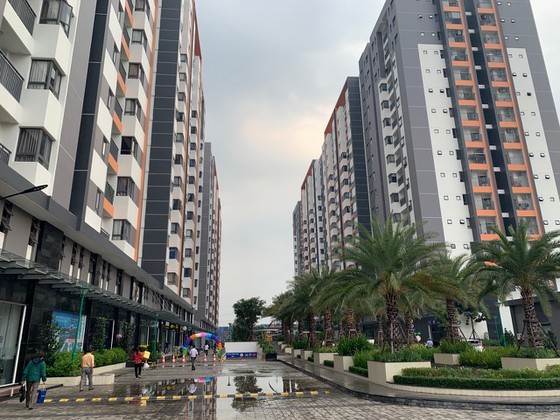
After the policy to control credit into risky sectors, credit growth of the real estate sector reached 8.8 percent last year, lower than general credit growth of 13.5 percent of the whole industry. However, the bad debts of this sector were kept at a low level of 1 percent. This showed that credit into real estate has been selected recently.
Mr. Nguyen Quoc Hung, Director of the SBV’s Credit Department, explained that the Circular No.22/2019 of the SBV instructs the roadmap by 2022, in which the maximum proportion of short-term capital used for medium and long-term loans will be reduced from 40 percent to 37 percent by October this year and to 30 percent by 2022, is to control the risk in real estate loans, not to squeeze credit into real estate sector.
Circular No.22/2019 does not impact negatively on real estate market but directs banks to give loans to clients who actually have demand for housing to promote the development of affordable and social housing segments which are currently short of supply, instead of buying houses for trading. This policy is stated clearly in the regulations on real estate loans below VND1.5 billion that the loans for buying social houses and houses in the projects and programs supported by the Government will be applied risk factors of 50 percent, he said.
At the recent conference ‘Vietnam Investment and Business Development 2020’ held by Bizlive, economic expert Can Van Luc said that last year, the real estate market in Hanoi and Ho Chi Minh City both faced difficulties in supply, of which, HCMC’s real estate market saw a decline of 52 percent in supply and Hanoi’s counterpart 26 percent, so the property prices were pushed up amid the context that the market was much less vibrant than the previous year. Property prices in HCMC surged by 12 percent and those in Hanoi 6 percent in 2019, depending on each segment and area. Meanwhile, the real estate market of some other provinces posted a fairly good growth.
This shows that the property market is still in the process of selection and is not too pessimistic. Business results of listed real estate enterprises last year were fairly good with stock prices increasing by around 13 percent on average compared to the previous year. Different from the real estate credit growth given by the SBV, Dr. Can Van Luc said that credit for real estate grew by 14.5 percent on average.
Circular No.22/2019 will generate more positive impacts on the real estate market as loans for buying and repairing houses are only imposed risk factors of 50 percent whereas real estate trading is imposed risk factors of 200 percent, said Mr. Luc.
Actually, amid the context of the risk of an outbreak of bad debts when pumping credit into real estate, commercial banks have promoted loans for buying houses, especially residential houses, instead of focusing credit for housing projects’ investors.
Specifically, by the end of September last year, the total outstanding mortgage loans of Techcombank reached VND81 trillion, up 52 percent compared to that at the beginning of the year and up 67 percent over the same period last year. Meanwhile, the average growth rate from 2015 to 2018 was 24 percent.
According to ACB, this year, the retail sector is estimated to reach VND130 billion, or more than 50 percent of the total outstanding loans, of which, loans for buying and repairing houses account for 35 percent.
Similarly, Vietcombank has been controlling well real estate loans but still encourages loans for buying residential houses because this segment not only has great potential but risks also are dispersed.
Mr. Nguyen Quoc Hung, Director of the SBV’s Credit Department, explained that the Circular No.22/2019 of the SBV instructs the roadmap by 2022, in which the maximum proportion of short-term capital used for medium and long-term loans will be reduced from 40 percent to 37 percent by October this year and to 30 percent by 2022, is to control the risk in real estate loans, not to squeeze credit into real estate sector.
Circular No.22/2019 does not impact negatively on real estate market but directs banks to give loans to clients who actually have demand for housing to promote the development of affordable and social housing segments which are currently short of supply, instead of buying houses for trading. This policy is stated clearly in the regulations on real estate loans below VND1.5 billion that the loans for buying social houses and houses in the projects and programs supported by the Government will be applied risk factors of 50 percent, he said.
At the recent conference ‘Vietnam Investment and Business Development 2020’ held by Bizlive, economic expert Can Van Luc said that last year, the real estate market in Hanoi and Ho Chi Minh City both faced difficulties in supply, of which, HCMC’s real estate market saw a decline of 52 percent in supply and Hanoi’s counterpart 26 percent, so the property prices were pushed up amid the context that the market was much less vibrant than the previous year. Property prices in HCMC surged by 12 percent and those in Hanoi 6 percent in 2019, depending on each segment and area. Meanwhile, the real estate market of some other provinces posted a fairly good growth.
This shows that the property market is still in the process of selection and is not too pessimistic. Business results of listed real estate enterprises last year were fairly good with stock prices increasing by around 13 percent on average compared to the previous year. Different from the real estate credit growth given by the SBV, Dr. Can Van Luc said that credit for real estate grew by 14.5 percent on average.
Circular No.22/2019 will generate more positive impacts on the real estate market as loans for buying and repairing houses are only imposed risk factors of 50 percent whereas real estate trading is imposed risk factors of 200 percent, said Mr. Luc.
Actually, amid the context of the risk of an outbreak of bad debts when pumping credit into real estate, commercial banks have promoted loans for buying houses, especially residential houses, instead of focusing credit for housing projects’ investors.
Specifically, by the end of September last year, the total outstanding mortgage loans of Techcombank reached VND81 trillion, up 52 percent compared to that at the beginning of the year and up 67 percent over the same period last year. Meanwhile, the average growth rate from 2015 to 2018 was 24 percent.
According to ACB, this year, the retail sector is estimated to reach VND130 billion, or more than 50 percent of the total outstanding loans, of which, loans for buying and repairing houses account for 35 percent.
Similarly, Vietcombank has been controlling well real estate loans but still encourages loans for buying residential houses because this segment not only has great potential but risks also are dispersed.
 An affordable housing project in District 9 in Ho Chi Minh City. (Photo: SGGP)
An affordable housing project in District 9 in Ho Chi Minh City. (Photo: SGGP)
Credit into real estate has been strictly controlled, so, recently, real estate enterprises have flocked to issue corporate bonds. Statistics showed that last year, the total number of corporate bonds was up to VND245 trillion, of which, around 50 percent of its belongs to real estate enterprises.
Noticeably, the buyers of real estate corporate bonds were banks. This has raised concerns that this is the way they go around the regulations to pour credit into real estate because when banks buy corporate bonds, it will not be recorded as outstanding loans. Meanwhile, the real estate corporate bond market has strongly increased recently, giving worries about its safety when the capacity and credibility level of enterprises have not been confirmed, along with high-interest rates and a lack of transparency and efficiency in their capital using plans. Even some real estate firms that were running at losses were still able to mobilize trillions of Vietnamese dong via bond issuance, causing huge risks for investors and the market.
Mr. Truong Van Phuoc, a member of the Prime Minister's Economic Advisory Group, said that the restriction of credit growth into risky sectors, including real estate, in recent years has forced real estate companies to put more effort into seeking the capital through bond issuance.
For the corporate bond market to develop sustainably and to reduce risks for investors, it is necessary to have the regulations on credit rating of bond issuers. When the bond issuers are transparent, corporate bond is a channel to attract capital in order to reduce dependence on bank loans as currently.
From another perspective, Dr. Can Van Luc said that in the financial statement, outstanding loans and investment in bonds are two different accounts. Commercial banks must report the SBV about their real estate investment situation, including loans as well as purchases of real estate corporate bonds, so concerns that banks sidestep the regulations on credit for real estate by buying bonds are groundless. Credit for real estate has gradually decreased, but generally, the real estate market still relies on bank credit.
According to statistics, in the first nine months of last year, banks had pumped around VND53 trillion of loans for real estate trading and investment enterprises. If including the total volume of credit pumped into the real estate market, consisting of mortgages, the figure would be up to VND1.6 quadrillion last year, accounting for 20 percent of total outstanding loans, showing that banks are still the largest capital supplier for the real estate market.
However, the quality of real estate loans has been better than before as banks select carefully before giving loans. Although it is necessary to control risks, to diversify the capital for the real estate market, it should not rush to tighten real estate bonds as though the proportion of the capital mobilized by bonds of real estate enterprises increased, it was still much smaller than the total volume of capital poured into this market.
Noticeably, the buyers of real estate corporate bonds were banks. This has raised concerns that this is the way they go around the regulations to pour credit into real estate because when banks buy corporate bonds, it will not be recorded as outstanding loans. Meanwhile, the real estate corporate bond market has strongly increased recently, giving worries about its safety when the capacity and credibility level of enterprises have not been confirmed, along with high-interest rates and a lack of transparency and efficiency in their capital using plans. Even some real estate firms that were running at losses were still able to mobilize trillions of Vietnamese dong via bond issuance, causing huge risks for investors and the market.
Mr. Truong Van Phuoc, a member of the Prime Minister's Economic Advisory Group, said that the restriction of credit growth into risky sectors, including real estate, in recent years has forced real estate companies to put more effort into seeking the capital through bond issuance.
For the corporate bond market to develop sustainably and to reduce risks for investors, it is necessary to have the regulations on credit rating of bond issuers. When the bond issuers are transparent, corporate bond is a channel to attract capital in order to reduce dependence on bank loans as currently.
From another perspective, Dr. Can Van Luc said that in the financial statement, outstanding loans and investment in bonds are two different accounts. Commercial banks must report the SBV about their real estate investment situation, including loans as well as purchases of real estate corporate bonds, so concerns that banks sidestep the regulations on credit for real estate by buying bonds are groundless. Credit for real estate has gradually decreased, but generally, the real estate market still relies on bank credit.
According to statistics, in the first nine months of last year, banks had pumped around VND53 trillion of loans for real estate trading and investment enterprises. If including the total volume of credit pumped into the real estate market, consisting of mortgages, the figure would be up to VND1.6 quadrillion last year, accounting for 20 percent of total outstanding loans, showing that banks are still the largest capital supplier for the real estate market.
However, the quality of real estate loans has been better than before as banks select carefully before giving loans. Although it is necessary to control risks, to diversify the capital for the real estate market, it should not rush to tighten real estate bonds as though the proportion of the capital mobilized by bonds of real estate enterprises increased, it was still much smaller than the total volume of capital poured into this market.
























